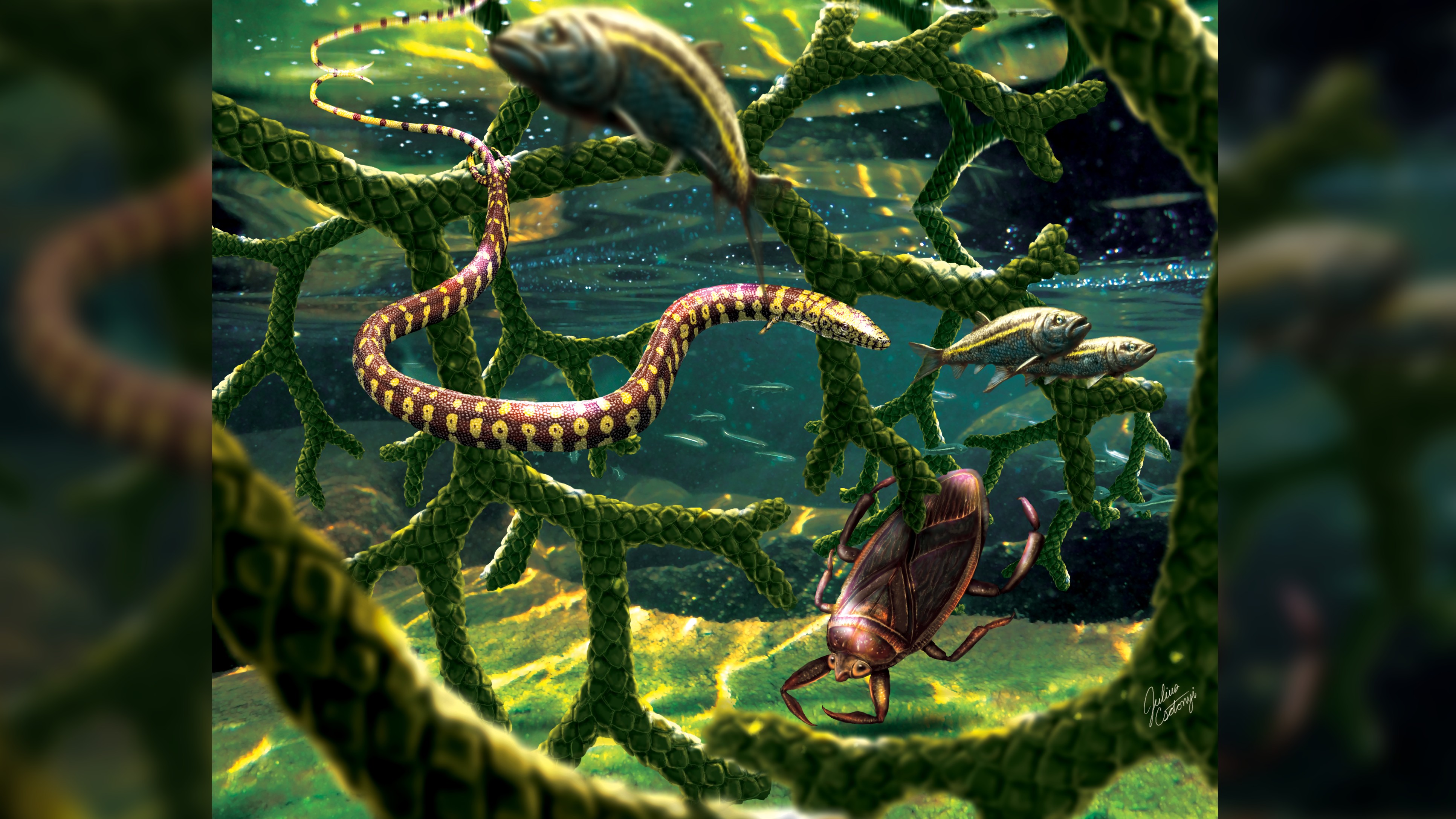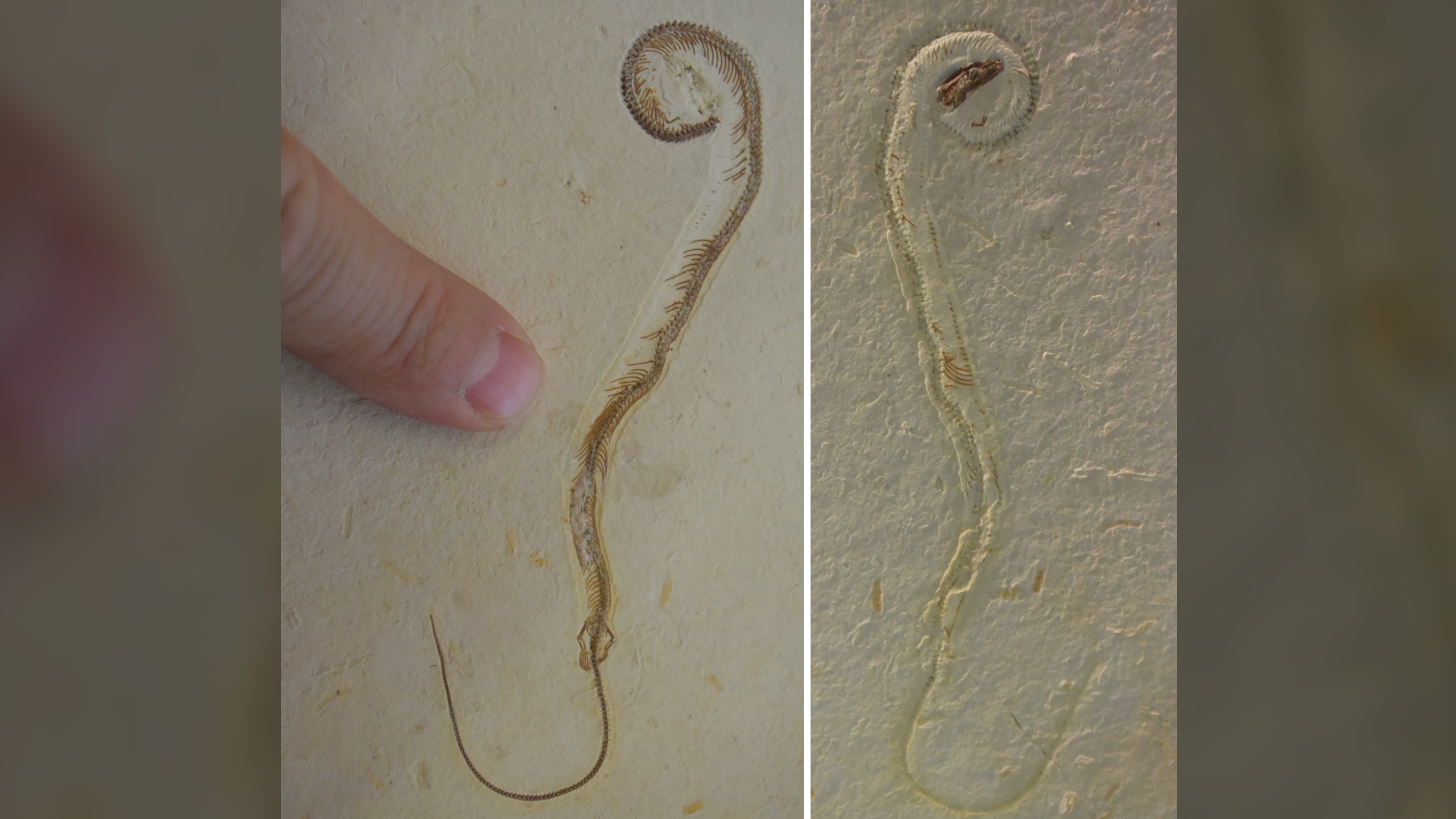4-legged 'snake' fossil is actually a different ancient animal, new study claims
The pencil-size fossil was previously believed to be the first four-legged snake.

A dinosaur-age fossil heralded as the first four-legged snake known to science might actually be an entirely different beastie, a new study claims.
The tiny fossil, about the length of a pencil at 7.7 inches (19.5 centimeters) long, is likely a dolichosaur, a now-extinct marine lizard with an elongated body that lived during the Cretaceous Period (145 million to 66 million years ago), the researchers of the study found.
After studying the remains of the creature, known as Tetrapodophis amplectus (the genus in Greek means "four-legged snake", while the species is Latin for "embracing") the new team found that the specimen doesn't have key anatomical features characteristic of snakes, said study lead researcher Michael Caldwell, a professor in the Department of Biological Sciences and the Chair of the Faculty of Science at the University of Alberta in Edmonton, Canada.
Moreover, the new study blasts the treatment of the Tetrapodophis fossil, which may have been illegally exported from Brazil and whose original study didn't include any Brazilian researchers, despite a Brazilian law stating that their country's researchers need to be included in the study of Brazilian specimens.
Related: Photos: Weird 4-legged snake was transitional creature
Scientists have long postulated that snake ancestors had four legs; two 2016 studies in the journal Cell that looked into snake genetics suggested that snakes lost their limbs about 150 million years ago due to genetic mutations, and other research has even found fossil evidence of a two-legged snake. But Tetrapodophis, whose discovery was announced in 2015 in the journal Science, remains the only four-legged snake fossil on record.
The 2015 study suggested that when it was alive 120 million years ago, Tetrapodophis used its four limbs, each with five digits, not for walking but for grasping partners during mating and gripping combative prey while hunting, Live Science previously reported. This animal was likely part of the shift from ancient lizards to modern-day snakes, and probably evolved from terrestrial-burrowing animals, the researchers said.
Sign up for the Live Science daily newsletter now
Get the world’s most fascinating discoveries delivered straight to your inbox.
But that interpretation of the fossil didn't sit well with Caldwell and Robert Reisz, a co-author of the new study and a vertebrate paleontologist at the University of Toronto. So, they flew to Germany, where the privately owned fossil was on display at the Solnhofen Museum (formerly known as the Bürgermeister-Müller-Museum) to do their own microscopic evaluation of Tetrapodophis, which they first presented at the Society of Vertebrate Paleontology annual meeting in 2016.
New findings
The new team found evidence that Tetrapodophis was more lizard-like than serpentine, especially in the skull, the researchers reported in the new study, published online Nov. 17 in the Journal of Systematic Palaeontology. Most of the skull's bones were "crushed like an eggshell," with pieces of shattered skull on one slab and the natural mold of the skull on the counterpart, Caldwell said. "The one thing that was completely ignored by the original authors is the counterpart of the skull," he said. "It's in the natural mold where we see some other features that are lizard-y, not snake-y."
The researchers found that Tetrapodophis’ body was also not snake-like. For instance, the skinny Tetrapodophis fossil is missing zygosphenes and zygantra, the stabilizing systems in the vertebrae that help a snake slither back and forth, and it has long, straight ribs, indicating that it was a swimmer, not a burrower, as the original study said. "Burrowing critters tend to be long and tubular," Caldwell said.
Dolichosaurs are closely related to snakes, said study co-author Tiago Simões, a postdoctoral fellow at the Museum of Comparative Zoology at Harvard University. So, perhaps it's no surprise that the original authors thought that Tetrapodophis was a snake, the researchers said.
However, it's not an open-and-shut case. "Tetrapodophis is a fantastic fossil, showing a unique combination of features not seen in any other squamate [lizards, snakes and amphisbaenians]," said Bruno Gonçalves Augusta, an associate researcher at the Museum of Zoology at the University of São Paulo and Southern Methodist University in Texas, who was not involved in either study. But some of the new conclusions drawn from the fossil counterpart, or mold, should be handled with caution, he said.
"For instance, I disagree with their interpretation of the quadrate [skull bone] morphology, since the actual bone is not preserved on the fossil, only a natural impression (a mold) is present … which I don't think is a reliable source of information," Gonçalves Augusta told Live Science in an email.
Other scientists can't get an independent look at the fossil because the privately owned specimen is not available to scientists, Gonçalves Augusta added. "It is not even possible to make firsthand observations and properly study the specimen anymore," he said.

Ethical quandary
The original researchers are standing by their interpretation of the fossil, which they believe shows "that the animal is the oldest and most primitive known snake," David Martill, study co-researcher of the 2015 study and a professor of paleobiology at the University of Portsmouth in the United Kingdom, told Live Science.
The fossil is from the Crato Formation in Brazil, which was largely excavated in the 1970s and the following decades. This means that Tetrapodophis was likely removed from the country after the Decree Law of 1942, which states that holotypes (the first discovered specimen of a new species) must stay in Brazil, and that paratypes (subsequently discovered fossils of a species) can be exported only with permits, the researchers of the new study said. Because the provenance of Tetrapodophis is unknown but highly suspect, the Brazilian Federal Police have launched an investigation into it, the researchers wrote in the new study.
Martill noted that "We'd be happy to see the fossil returned to Brazil, but it was not our fossil, and therefore not our decision to make." But he said that the law surrounding fossil exports from Brazil wasn't always enforced in the 1970s and 1980s (which the new team says is no excuse for violating the law).
"I've got no problem with these fossils going back to Brazil, provided Brazil doesn't burn its museums down," Martill said. "I mean, they had that massive tragedy when their Museum of Natural History in Rio [de Janeiro burned down."
But it's unlikely that the 2018 fire played a role in this case, the new study's authors said. "Unless Dr. Martill is prescient, I have a hard time believing he was predicting future museum fires while standing in a private museum in Solnhofen seeing the fossil for the first time two or three years before his 2015 paper," Caldwell told Live Science in an email.
Others supported the fossil's return to Brazil.
"I agree when the authors state how important it is to the fossil to be returned to a public research institute in Brazil," Gonçalves Augusta said. "Fossils are a significant part of a country's heritage, and they should be available for any scientific study, which is not the case for Tetrapodophis at this moment."
Originally published on Live Science.

Laura is the archaeology and Life's Little Mysteries editor at Live Science. She also reports on general science, including paleontology. Her work has appeared in The New York Times, Scholastic, Popular Science and Spectrum, a site on autism research. She has won multiple awards from the Society of Professional Journalists and the Washington Newspaper Publishers Association for her reporting at a weekly newspaper near Seattle. Laura holds a bachelor's degree in English literature and psychology from Washington University in St. Louis and a master's degree in science writing from NYU.










